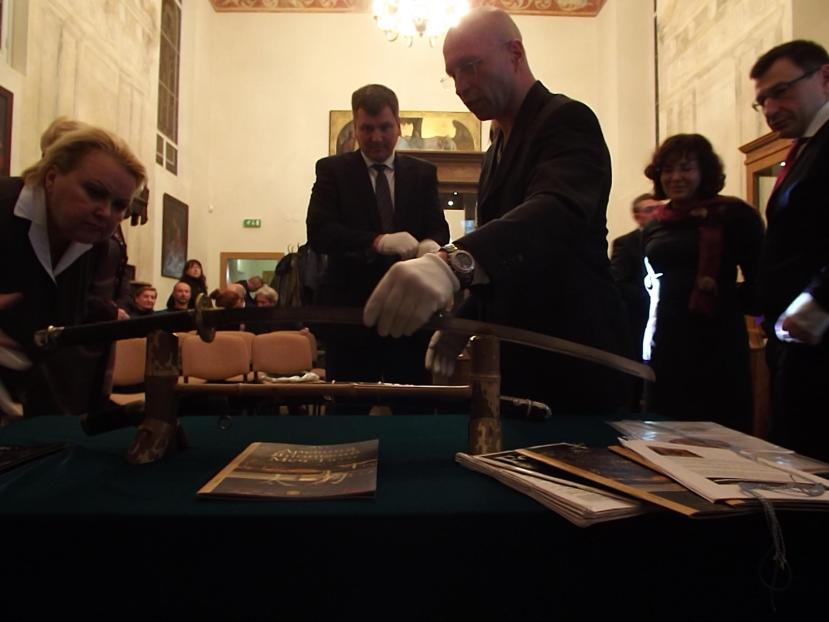
This rare 16th-century Samurai Tachi sword belonged to Fukushima Masanori, a powerful warlord in feudal Japan.
In Japanese ‘Tachi’ (太刀) means ‘Long Sword.’ It was the largest sword in Samurai’s arsenal, far bigger than Katana or Wakizashi. In fact, preceding the development of the Katana, it was Tachi that was the original traditional sword of the legendary Samurai warrior. Tachi, Katana, and Wakizashi differ not only in length and curvature, but also in how they are worn when sheathed.

This Tachi sword belonged to one of the most famous warriors and daimyos (feudal lords) in Japanese history – the great Fukushima Masanori (1561–1624). He is known as one of the Seven Spears of Shizugatake for his actions in the Battle of Shizugatake, where he had the honor of first blood. Throughout his life, he fought in many campaigns, including the Battle of Ch’ungju during the Japanese Invasion of Korea in 1592.

Also Read: The Most Expensive Gold Antique in the World – $35 Million Persian Necklace
To this day, Masanori is widely featured in Japanese media as a heroic Samurai warrior. It is hard to imagine that this Tachi sword was once held and possibly used in battle by Fukushima Masanori himself. Perhaps it was even the sword that drew first blood in the Battle of Shizugatake.

This Tachi is from 16th-century Japan, dating to the end of the Koto period. The 16th and 17th centuries were especially dangerous for Tachi swords. When close-combat style became popular, the use of long swords diminished. Many Tachi swords were shortened into Katanas and lost their uniqueness. Because they were large and difficult to conceal, the relentless destruction of these Samurai weapons, and especially long swords, continued until the middle of the 20th century. Today an authentic Tachi sword in mint condition is a truly rare discovery.

The blade of a Samurai sword is a technological marvel. Experts around the world agree that an authentic Samurai sword is a perfection of a bladed weapon in every way. In some cases it took as much time and effort to create a well-crafted Samurai sword as it took Michelangelo to paint the ceiling of the Sistine Chapel. The decorations on these swords are works of art in themselves. It required as much artistic skill and inspiration to decorate an important Samurai sword as for Leonardo Da Vinci to paint the Mona Lisa.
Also Read: The Most Expensive Gold Antique in the World – $35 Million Persian Necklace

The Samurai sword symbolizes all of the best traits of the Japanese people: perfectionism, strength, elegance, ingenuity, imagination, craftsmanship, and artistic genius. Because of that, it is perhaps the most widely known bladed weapon in the world.

Today there is a clear tendency to value ancient Samurai swords for their unrivaled craftsmanship, for their unique history, for their cultural power, to even value them aesthetically as visual art. However, the time has finally come to value them financially. Without a doubt all ancient Samurai swords of significant historical importance must be classified and treated as world treasure.

This Tachi is currently in the Tamoikin Art Fund and is considered to be one of their most valuable assets. It has been appraised at over $105 million and was featured in the prestigious Forbes 400 Special Edition magazine in USA, EU, and Asia, as well as in Forbes Korea.





In the photos below, Prof. Mikhail Tamoikin, Ph.D., vice president of the Tamoikin Art Fund, hold Masanori’s Tachi sword during its first public exhibition that was held in 2013 in the Trakai Island Castle, Lithuania.



Also Read: The Most Expensive Gold Antique in the World – $35 Million Persian Necklace
Story submitted by Tamoikin Art Fund. The World Art News (WAN) is not liable for the content of this publication. All statements and views expressed herein are only an opinion. Act at your own risk. No part of this publication may be reproduced without written permission. © The World Art News
Categories: Artifacts & Archeology, Asia, Investigations, Prices






















Who should I contact if I believe that I have a sword very similar to this and looking to sell it? I’m having a hard time trusting anyone to even try to appraise it.
Hi Brandon….It’s good to be skeptical of some folks because like with any collectible – there are those who would low ball you when trying to sell your sword. There are a number of people out there, depending on where you are who can give you a ballpark idea – collectors and dealers….you could even take some pictures of the blade, fittings and the nakago and post them on the nihonto message board and ask for some assistance. You could also go to some sites (there are MANY) that deal in swords, fittings and armor like AOI ART in Japan, Unique Japan, etc and see if there is anything that looks similar to what you have…you could also email me privately and I might be able to give you some idea.
For such a valuable sword, this bade is in terrible condition. Japanese sword collectors would be applalled at the condition of that blade, with many chips in the edge and active rust on the surface of the blade. The blade is in such poor condition there is not even a hint of the blades hamon (temper pattern). I highly doubt that this sword is worth anywhere near 100 million dollars. I have seen swords that were far older in perfect condition. The most expensive sword ever sold at auction sold for less than half a million dollars. it was a sword from the 13th century (Kamakura Period) which was sold to an anonymous collector for the sum of $418,000.
I have two and dont know the values, like to know.
Just curious how a Japanese sword with this valuation is not polished. I am a newer collector but kissaki looks poorly shaped, the nakago is a very strange shape and mei is poorly done. Do you have any papers proving authenticity as a Tokubetsu Juyo Token piece of work from NBTHK or similar society? And if not, how did you come to this valuation as my understanding is that the most expensive blade ever sold was less than five million (USD), I believe… Even right now in 2024 there is a town in Japan buying back a blade for about 3 million (USD) and this is listed as one of the top five most expensive blades ever sold. Let me take a guess, this one is still available, correct? Koshaire looks as if it may be authentic, I may be willing to make an offer on that, but guessing by your sword value, we will not be on the same planet, never mind page… Best of luck to you but I think you are going to eventually hear news that you will not like.
How did they acquire this sword, how did it leave Japan? Wouldn’t this be considered an important cultural property. How was it’s authenticity verified? I cant find any news on this sword expect from this site.